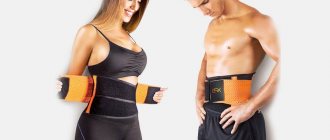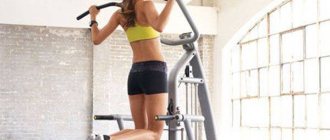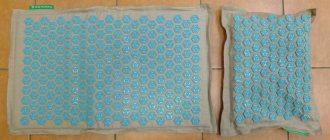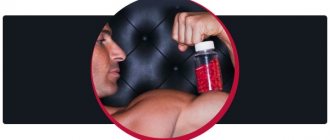Powerlifting equipment is divided into casual and competition. Competitiveness refers to something that significantly affects the results in exercises.
These include bench press shirts, barbell squat suits, and knee wraps.
Everyday powerlifting (and fitness) gear is designed to keep you from getting injured. These are an athletic belt, knee pads, elbow pads and wrist wraps.
They can and do affect the result, but only slightly.
This article discusses issues related to the use of an athletic belt. What is the difference between a powerlifting belt and a weightlifting belt?
Powerlifting belt (alethic belt)
Although the whole thing is called an “athletic belt,” there are two types of belts: weightlifting and powerlifting. They differ in structure. Usually in the gyms you can find a weightlifting belt - it is narrower in front than in the back.
TA exercises require sufficient flexibility, so the athlete must be able to lean forward.
In powerlifting, this is rather a disadvantage (less rigid design - less weight can be lifted), so the powerlifting belt is equally wide on all sides.
This is what a weightlifting belt looks like:
The powerlifting belt is equally wide on all sides. And for regular training it is recommended.
If you don't do barbell snatches, you'll benefit more from a wide belt than a narrow one.
Other characteristics
Note that multi-layer belts made of genuine leather, stitched with a zigzag pattern, are absolutely wear-resistant and flexible. Thanks to this, the accessory can easily be adjusted to the characteristics of each figure.
I would also like to advise those who are thinking about how to choose a weightlifting belt to pay attention to the quality of the holes. The latter should be framed with eyelets.
If you plan to purchase an accessory that is not made of leather, then be picky when choosing a product. It must be carefully executed and have a trademark. When buying a cheap Chinese product, you need to be prepared for the fact that it will not last long.
Read also: Powerlifting - Wikipedia with video
Materials for making an athletic belt
Belts vary in the materials from which they are made. Usually it is leather or nylon. The nylon belt is “sold” to beginners and girls - it is lighter and does not look so massive. However, be careful!
This belt is really soft, but this is its main disadvantage. If you lift anything heavier than 3kg dumbbells, the belt will come loose and twist. From my point of view, the effectiveness of such a belt tends to zero.
Pay attention to the fastening method: it is Velcro that goes through the carabiner. Since the Velcro itself is soft, it wrinkles and twists - as a result, the belt unfastens right during the approach. Which can lead to injury.
On the other hand, such a belt can be worn all day if you have strained your lower back. It is very light and hides well under clothes.
So a soft fitness belt is more of a rehabilitation tool than a real aid in training.
Another thing is a real powerlifting belt. It is equal to 10 centimeters. The width is established by the rules and is not changed by manufacturers. The thickness of the belt may vary. You will find a variety of options - 7, 10 and 13 mm.
Belt fastening systems
Regular - with one tongue, like a regular belt for pants. The simplest and cheapest option, period. Most often found in the halls.
The second version of the buckle has 2 tongues. A tighter fastening means the belt will potentially last longer. I recommend it for use.
Personally, I like the double-tongue buckle better, but that's more of a personal preference than a fact. Here's a fact: fastening a belt with two tongues is much more difficult than with one. Keep this in mind before you make a purchase.
The most expensive and most convenient option is a belt with a carabiner. Very easy to tighten.
The problem is that they often break. Really often. It's a movable structure with a lot of parts, so there's a lot to break.
Tip: to easily tighten the tightest and thickest athletic belt, just lie on your back. Give it a try.
Belts with a lever break very often, so this is definitely not a reliable option. This type of belt has the advantage of being much easier to put on and take off.
On the other hand, the belt is not like knee bandages; the whole process of putting it on takes 5-10 seconds anyway.
In fact, the advantages of the lever are quite weak, but the disadvantages (fragility) are critical.
Conclusion : to start, take a belt with 1 tongue.
Recommendations for purchasing
There are selection criteria by which you can choose a model for sports and decide which company is better.
Type
Athletic belts come in several varieties:
- classic – the wide part of the product is located in the lumbar region, the minimal part is adjacent to the abs;
- wide – characterized by pronounced massiveness;
- cloth – made of dense woven fabric, intended for beginner athletes.
What material is it made of?
Weightlifting belts can be made from the following materials:
- Genuine Leather;
- leatherette;
- synthetics.
An important indicator when selecting is the degree of tensile strength. From this point of view, popular leather models are considered the most durable. However, the best leather belts are much more expensive. Leatherette belts are more affordable. You can lift small loads using a synthetic belt with Velcro.
The manufacturing material must be hygroscopic, durable, and moderately elastic.
Size
Before choosing a suitable product, it is recommended to focus on the review of the fitting. When fastened, the buckle should be in the middle of the entire fastening area. As body dimensions may change, you may need to loosen or tighten the belt a couple of notches. As a rule, sizes are determined in accordance with generally accepted measurements. However, some manufacturers focus on their own size chart.
size table
| Size | Waist (cm) |
| S | 62-80 |
| M | 72-90 |
| L | 82-100 |
| XL | 92-110 |
| XXL | 102-120 |
Mounting method
This type of equipment can be fixed manually or automatically. Professional athletes recommend giving preference to the first option. The main condition is the strength of the fastening element.
The following types of fasteners are used for such products:
- standard buckle;
- carabiner buckle;
- Velcro fastening.
Velcro belts are relatively inexpensive and are designed for lifting light weights. For other cases, select a belt with a standard buckle or carbine buckle. Many athletes prefer automatic fasteners, considering them the most convenient and reliable.
Availability of a chain for weights
The weight chain is an additional attribute. There are a large number of models with such a chain on the market.
Flexibility
The proper quality of the product is indicated by the presence of several layers of leather and stitching with a zigzag seam. It is these belts that are most durable and can perfectly take the shape of the body.
Price
Belts made of genuine leather are very expensive compared to their artificial counterparts. However, you should not take a cheap one due to the fragility of woven fabric. Saving on quality may result in the need to purchase a new product.
As an alternative to a leather belt, you can look for a product made from a combined material. Natural and synthetic fabrics are used to make such belts.
Equipment made from artificial leather is the most attractive in terms of cost. However, such sports equipment is not durable.
It should also be noted that all weightlifting belts are divided into men's and women's.
Athletic belt thickness
There are two basic belt thicknesses: 10 and 13 mm. The thicker the belt, the more support it offers. It's simple. So if you use a belt, make sure it gives you as much support as possible, right?
Some people complain that the tight 13mm belt causes discomfort. There is nothing to say in advance.
Happens. If you have a small distance between your pelvic bones and your ribs, the belt may dig into the bones. It's painful and unpleasant, but that's life.
Take a belt from a friend to try it out in training and you’ll understand for yourself.
A 13mm waistband is recommended because it gives maximum support. The purpose of a powerlifting belt is not only to protect, but also to improve.
The thicker the belt, the better.
Conclusion : 13 mm!
What are the types
There are two types of belt:
- weightlifting - can be of different widths. The widest part is adjacent to the lower back. It is flexible and easy to use for bending exercises. Most suitable for bodybuilding.
- for powerlifting - the equipment has the same ten-centimeter width along its entire length. Placed on the area close to the pelvic bones. The product is strong, massive, and fits quite tightly. Has considerable thickness. Best suited for exercises that require a straight back.
How to use an athletic belt correctly
The basic rule is to tighten it on sets, loosen it between sets. You need to breathe. A belt is a must-have tool in training. Many people put on a belt as soon as they enter the gym. During warm-up approaches, you can not tighten the belt too much, but also not give it any slack.
Starting with semi-working sets (for example, from 50% of the one-rep maximum), begin to tighten the belt. The belt protects the lower back, and its injuries take a long time and are difficult to treat.
Working with a belt is active, not passive.
You need to take a full deep breath, and then actively press your abdominal wall into your belt, as if you are trying to stretch it.
Position of the athletic belt on the stomach
There are three possible positions for tightening the belt: low, middle and high. In the bottom position, you tighten the belt just above your pelvic bone.
In the top position, you tighten the belt just below your ribs.
- For deadlifts, it is better to lower the belt to the lower third of the abdomen.
- For squats and bench presses, the middle position of the belt is optimal.
- For the bench press, it is better to tighten the belt on the upper third of the abdomen.
At least try it. Your specific case may feel different, but on average across the hospital, these are the recommendations that work.
How to use a lifting belt for squats
The squat and deadlift are the two movements where the belt produces the biggest gains.
Using the example of a squat.
- We took the barbell on our shoulders, took a step back, and stood up.
- Inhale, PLUG your belly into your belt. The goal is to push your abdominal muscles forward!
- Sat down
- As you rise, actively push your stomach forward. Notice how much easier it becomes to get up.
- There is no need to constantly contract your abdominal muscles, this will make things worse. Just as you started pushing, continue.
The optimal position of the belt for a squat is in the middle. If you have a normal body structure, feel free to tighten it in the middle and everything will be fine.
If you have very little space between your hip bones and your ribs, the belt can dig into the bones (especially with classic deadlifts).
In this case, you can take a belt that is narrower in front than in the back.
How to Use a Deadlift Belt
A good option is to tighten the belt in the lower position. This ensures optimal fixation of the lower back and adequate intra-abdominal pressure.
If you pull with a sumo deadlift, almost any position of the belt will not interfere with you.
It's a completely different matter if you use a classic deadlift. If you have a large belly or (I repeat) a small distance between the pelvic bones and ribs, you may encounter an unpleasant situation: the belt will dig into the pelvic bones.
It is painful, unpleasant and leaves quite noticeable bruises that take a long time to pass.
There are several options to solve the problem:
- Tighten the belt under your ribs. The higher it is, the less it will come into contact with the pelvic bones
- Use a belt that is narrower at the front. It will put less pressure on the bones, but the help from such a belt will be much less significant. The surface of the belt is smaller, the area into which you will press with the abdominal muscles is smaller, and the intra-abdominal pressure is less.
- Some athletes recommend tightening the belt the other way around - the buckle will be on the back. I don't know about the effectiveness of this method, but if you have problems, it's definitely worth a try.
Wearing rules
Constantly wearing a belt weakens your own muscles. The press loses tone, and the risk of injury increases with light loads. A weightlifting belt is not suitable for training with light weights. If your body is accustomed to the weightlifting belt, choose a gradual weaning pattern. The goal is to strengthen the back and abdominal muscles, reducing the time of wearing the belt to a minimum.
Exercising without a belt causes the abdominal muscles to tense and retract. When using additional sports equipment, the muscles “stick out” the stomach. When returning to natural technique, athletes have to relearn.
Read also: Why do you need a hobby or passion?
- Wear the belt when performing weight-bearing exercises in a standing position while holding the weight overhead.
- Pay attention to working out your abs.
- As you get used to the weight, reduce the number of approaches using the belt.










